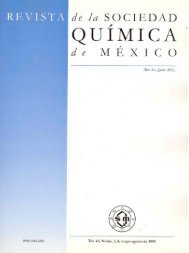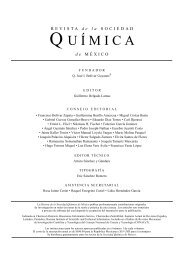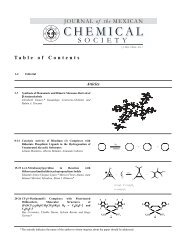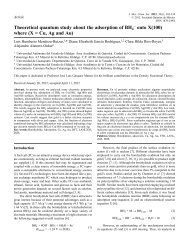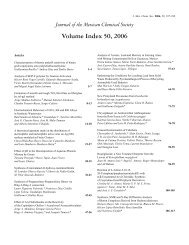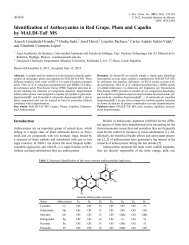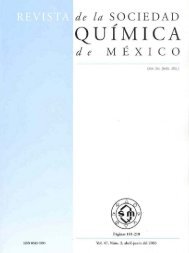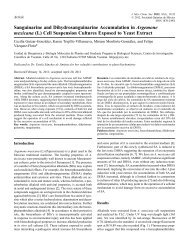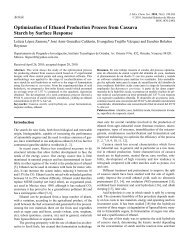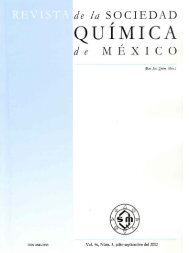SMQ-V043 N-001_ligas_size.pdf - Journal of the Mexican Chemical ...
SMQ-V043 N-001_ligas_size.pdf - Journal of the Mexican Chemical ...
SMQ-V043 N-001_ligas_size.pdf - Journal of the Mexican Chemical ...
You also want an ePaper? Increase the reach of your titles
YUMPU automatically turns print PDFs into web optimized ePapers that Google loves.
State-<strong>of</strong>-<strong>the</strong>-art Protein Structural Biology 25<br />
and its modification using molecular dynamics to yield a class<br />
<strong>of</strong> rationally modified mutant proteins which is followed by<br />
site-specific mutagenesis to syn<strong>the</strong><strong>size</strong> <strong>the</strong> mutant proteins. In<br />
our research on <strong>the</strong> structural biology <strong>of</strong> proteins we have successfully<br />
exploited such an integrated, hollistic approach<br />
which draws upon <strong>the</strong> salient features <strong>of</strong> both methodologíes<br />
and its symbiosis in order to derive <strong>the</strong> 3D structures <strong>of</strong> proteins<br />
and hence is able to maximize <strong>the</strong> structural information<br />
content. The approach is illustrated schematically in <strong>the</strong> flow<br />
sheet, shown in Fig. l.<br />
A number <strong>of</strong> polypeptide and protein structures upto M r =<br />
~21 kDa have been solved using such an integrated approach.<br />
The structure <strong>of</strong> a Ca ++ sequestering protein, amelogenin,<br />
which plays a critical role in developmental biology <strong>of</strong> mammalian<br />
tooth is illustrated here as an example. The method<br />
outlined is generic and is applicable to o<strong>the</strong>r protein systems.<br />
2. Bovine Amelogenin<br />
Fig. 1. Flow sheet illustrating a hollistic, integrated approach for<br />
deriving <strong>the</strong> 3D structure <strong>of</strong> a protein.<br />
teoglycans, lipoproteins, NMR remains <strong>the</strong> only avenue to<br />
determine <strong>the</strong> 3D structure in solution. The gap between<br />
known primary structures <strong>of</strong> proteins and <strong>the</strong>ir 3D structures<br />
is continuously increasing and hence <strong>the</strong>re is an urgent need to<br />
reduce <strong>the</strong> time span in <strong>the</strong> derivation <strong>of</strong> <strong>the</strong> 3D structures <strong>of</strong><br />
proteins. There has been a phenomenal increase in <strong>the</strong> knowledge<br />
<strong>of</strong> <strong>the</strong> protein primary structures i.e. <strong>the</strong> amino acid<br />
sequences, due to rapid advances in <strong>the</strong> gas-phase microsequencing<br />
and <strong>the</strong> derivation <strong>of</strong> <strong>the</strong> primary structure from<br />
<strong>the</strong>ir cDNA sequences. The secondary and tertiary structures<br />
<strong>of</strong> a few thousand proteins are known presently from X-ray<br />
and nuclear magnetic resonance (NMR) studies (Protein Data<br />
Bank, Brookhaven, New York, NY and European Molecular<br />
Biology Laboratory, Heidelberg, Germany) and <strong>the</strong>refore <strong>the</strong><br />
gap between <strong>the</strong> two continues to increase significantly.<br />
A multi-pronged approach in <strong>the</strong> elucidation <strong>of</strong> <strong>the</strong> 3D<br />
structures <strong>of</strong>fers much promise than any one method. We have<br />
recognized from <strong>the</strong> beginning that no one single physical<br />
method in structural biology can provide a complete picture <strong>of</strong><br />
protein structure and dynamics. Our ultimate goal is to develop<br />
rationally modified mutant proteins with enhanced function<br />
and explore <strong>the</strong>ir potential applications in biomedical, material<br />
science, electronics (Renugopalakrishnan et al., a series <strong>of</strong><br />
US Patents pending) and in technological areas. A rational<br />
modification <strong>of</strong> a protein begins with <strong>the</strong> experimentally<br />
derived 3D structure <strong>of</strong> <strong>the</strong> wild-type protein as <strong>the</strong> first step<br />
Amelogenin, a ~19 kD extracellular hydrophobic, phosphoprotein<br />
with an overall ellipsoidal shape (laser light seaterring<br />
studies from <strong>the</strong> author’s Harvard laboratory, unpublished),<br />
secreted by ameloblasts, from bovine tooth enamel contains a<br />
primary sequence which is unique in comparison to o<strong>the</strong>r<br />
known primary structures <strong>of</strong> mammalian proteins (Personal<br />
Communication, Hunt, 1989). It is characterized by a large<br />
proportion <strong>of</strong> Leu, His, Met, and Pro residues and contains a<br />
Fig. 2. A Comparison <strong>of</strong> <strong>the</strong> primary structure <strong>of</strong> bovine amelogenin<br />
(Takagi et al., 1983) with <strong>the</strong> primary structures <strong>of</strong> mouse, rat, pig,<br />
and human.




